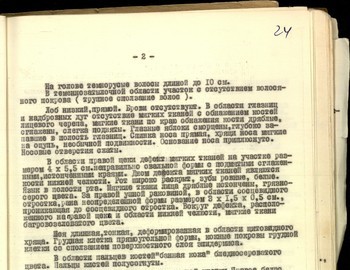
Autopsy report of Kolevatov
Sheet 23
city of Ivdel
Act №I
Medical-Forensic Examination of a body
On the May 9, 1959 in accordance with decree of the Prosecutor office of Sverdlovsk region of May 7, 1959 by forensic experts of the regional forensic investigation bureau V.A. Vozrozhdenniy in the presence of the criminal prosecutor of regional prosecutor office junior Counselor in Justice L.N. Ivanov and criminal expert Churkina G.A. in the morgue of the medical unit of the PO Box 240 with daylight and sunny weather there was performed the autopsy of the body of Aleksander Kolevatov, 23 years old, in order to determine the cause of death and answers to the questions given in the declaration.
Case circumstances
On January 23, 1959 the independent group of hikers consisting of 10 people went across the ski track Ivdel – Mount Otorten. From the 2nd Severny site the group consisted of 9 people. On February 1, 1959 the group started the climb on the mount Otorten and in the evening they put up a tent at the height of 1079 meters.
In the night of February 2 at the unknown circumstances all 9 people died.
А. External examination
On the examination table is a male body of proper constitution clothed as follows: a black zippered fustian ski jacket with right and left breast pockets with the unbuttoned cuffs still intact. There are defects in the fabric of the upper left sleeve of the jacket measuring 25 x 12 x 13 cm; the edges of the fabric in this area are burned. There is a tear measuring 7-8 cm on the right elbow of the jacket. Above the jacket is a brown fleece knitted sweater, and under this is a second ragged sweater of grey color and a checkered shirt with blue, red and black squares and two breast pockets. On the right pocket is a safety pin, and inside it is a key to a lock; the collar and the cuffs of the checkered shirt are closed. In the left pocket is a piece of brown paper and wrapping from a packet of ‘Codeine with Soda’.
A pale grey worn-out fleece undershirt. Canvas one-piece khaki pants with elastic support. In the right pants pocket is a soaked pack of matches. At the bottom of the pants there are cracked metal straps. Underneath them are baize ski pants with lateral buckles and a handkerchief in the pocket. On the feet are dirty white home-knitted wool socks, parts of which are burned, and brown cotton socks. On the left leg there are three brown cotton socks with a gauze bandage underneath them at the ankle joint. Pale grey underpants matching the shirt, and blue satin underwear.
The body is 174 cm in length, of proper constitution, and good nutrition.
Cadaverous crimson spots are located all over on the surface of the back right side of the trunk and the appendages. Rigor mortis has resolved in the muscle groups of the joints. The skin covering the face of the body is yellow grey with hints of purple.
Sheet 24
- 2 -
On the head is dark blond hair with a length of up to 10 cm. In the superior postcranial areare is a part where hair is missing (cadaverous hair slide).
The forehead is low and straight. There are no eyebrows. The skin is missing in the area of the eye sockets and eyebrows, exposing the facial bone; the soft tissue around the edge of the exposed bone is limp, smooth and slightly raised. The eyeballs are wrinkled and sunken into the eye sockets. The bridge of the nose is straight; the nose cartilage is soft when palpated and has unusual mobility. The base of the nose is flattened with the nostrils compressed.
There is a defect in the soft tissue in the area of the right cheek measuring 4 x 5.5 cm of uneven oval form with pressed smooth drawn-out margins. The bones of the lower jaw appear at the bottom of the defect of the soft tissue. The mouth is wide open, and the teeth are even and white. The tongue is completely in the mouth. The soft tissue of the face is thin, flaccid and of a dirty grey color. There is a wound of undetermined shape measuring 3 x 1.5 x 0.5 cm behind the right ear in the area of the mastoid process that penetrates into the mastoid process. Around the defect located on the right cheek in the area of the lower jaw, the soft tissue is of a purple-green color.
The neck is long and thin, and deformed in the area of the thyroid cartilage. The thorax is rectangular in shape. The surface layer of the epidermis is slipping from the skin covering the chest.
There is ‘bath skin’ of a pale grey color in the area of the fingers. The fingers are partially bent.
The stomach is located at the level of the chest. The right thigh is adducted to the left. In the area of the external surface of the right thigh there is an area of pitted soft tissue measuring 25 x 15 cm without hemorrhaging to the surrounding soft tissue.
The external genitals are properly formed and without any abnormalities. The opening of the anus is clear.
There is pale grey ‘bath skin’ in the area of the foot. The bones of the limbs are whole when palpated. On the inner surface of the left knee there is diffuse bleeding into the underlying tissue.
B. Internal examination
The skin flaps of the scalp are moist and of pale red color. The bones of the fornix of the brain and the base of the skull are whole. The dura matter has a bluish coloration and is sufficiently filled with blood. The pia matter is thin and cloudy. The gyrus and sulcus are poorly distinguished. The grey brain matter is poorly differentiated from the white. The ventricle contours of the brain are indistinguishable. The brain matter is of a gelatinous consistency. The blood vessels at the base of the brain are normal. The subcutaneous fat of body is sufficiently developed. The internal organs are properly arranged.
Sheet 25
- 3 -
The pleural cavity contained up to 500 cm3 of bloody fluid. The pericardium contained up to 13 cm3 of amber fluid.
The surface of the heart is lightly covered in fat. The size of the heart is 13 x 12 x 5 cm. The cardiac muscle is dark red in color when sectioned. The heart is lightly coated with fat on the surface. The right and left halves of the heart contained up to 100 cm3 of dark liquid blood. The valves of the heart, the aorta and the pulmonary artery are slightly thickened along the coaptation line. The coronary vessels of the heart are freely passable. The internal surface of the aorta is smooth and clear. The width of the aortic arch above the valve is 7 cm.
The surface of the lungs is blue-red in color and soft when palpated. When sectioned, the tissue is dark red in color. When the surface of the section is pressed, a large amount of foamy bloody liquid is released.
The openings of the larynx and bronchi are free. The hyoid bone is intact. The neck muscles and intervertebral cervical spine appear as remnants of soft tissue and are green-grey in color (putrefactive changes)
The stomach contained up to 100 cm3 of a pale red slimy mass. The gastric mucosa was swollen, loose, with well-defined folding and was blue red in color. When sectioned the pancreas was lobular and yellow-blue in color.
The surface of the liver was faint and smooth. The size of the liver was 23 x 15 x 12 x 7 cm. When sectioned the liver tissue was brown with a poorly discernible liver pattern. The gall bladder contained up to 5 cm3 of dark brown liquid; its mucous membrane was of a brown-green color. The lumen of the small intestine contained a pale red mucosal mass with hints of yellow. The lumen of the large intestine contained fecal matter that was brownish green in color. The mucous membrane of the intestine was blue-red in color and loose when palpated. When sectioned the tissue was dark cherry red in color. The pulp from the cut surface gives a small scraping. The size of the spleen is 9 x 7 x 2.5 cm. The surface of the kidneys was smooth and shiny; the capsule was easily removed from the kidneys. When sectioned, the tissue of the kidneys was dark red in color. The cortex and medulla were well-distinguished. The layers of the adrenal gland were poorly distinguished. The bladder contained up to 700 cm3 of murky yellow liquid. The mucous membrane of the bladder was blue.
For chemical and histological study, pieces of the internal organs of the body were removed.
| Medical examiner | signature | (Vozrozhdenniy) |
| Criminal prosecutor | (Ivanov) | |
| Forensic expert Sverdlovsk |
(Churkina) |
Sheet 26
- 4 -
Conclusion:
Based on the examination of the body of Kolevatov, I think that his death was the result of low temperature.
The injuries that appear on Kolevatov’s body in the area of his head – defects in the soft tissue and the ‘bath skin’ – are the result of post-death changes in the body, which was located in water for some time before it was found.
The cause of death of Kolevatov was through violence.
Forensic Medical Examiner - signature (Vozrozhdenniy)







